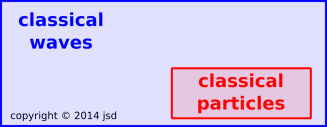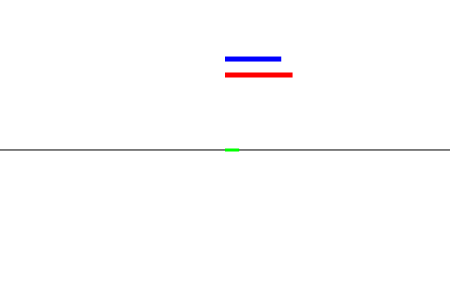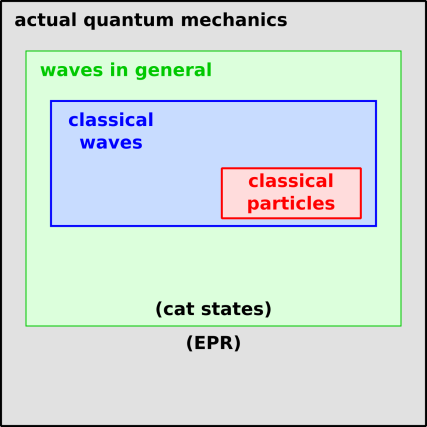Fields, and Excitations in the Fields
John Denker
In terms of fundamental physics, the most basic things are the
fields and the excitations of the fields. Sometimes the
excitations look particle-like, sometimes they look wave-like, rarely
both, often neither.
I mention this because lately I’ve been getting questions from several
directions about “wave/particle duality”. One could make a
pretty strong argument that there’s no such thing. The whole approach
is a Bad Idea. It’s not good technically, it’s not good
pedagogically, it’s just not worth the trouble. The smart approach is
to focus on the fields and the excitations in the fields, and not even
worry about what’s a particle and what’s not. Additional constructive
suggestions can be found in section 3.
1 Classical Considerations
For starters, duality is a symmetrical relationship. That is, if A is
the dual of B, then B is the dual of A. However, even if we restrict
attention to classical waves and particles, the relationship is not
symmetrical.
- It is possible to explain classical particles in terms of
classical waves: Just construct a wave packet. If the wavelength is
tiny compared to the overall size of the packet, you can make the
thing behave like a particle. In figure 1,
note that the medium – the field – is undisturbed before and after
the “particle” passes our window of observation.
- The converse does not hold. I don’t see any way to convert a
classical particle into a classical wave ... not in any way that
corresponds to item (1) above.
(Using the particles to create a fluid, and then setting up waves
in the fluid does *not* count. The resulting waves are in no
sense dual to the original particles. The resulting waves have
wave packets of their own, which are particle- like but not even
remotely similar to the original particles.)The only way I can see to convert a classical
particle to a classical wave is to say that it
was a wave all along, which brings us back to
item (1).
We can draw the diagram. Classical waves encompass
classical particles, and not vice versa, as shown
in figure 2.
 Figure 2
Figure 2: Classical Waves versus Particles
2 Real Quantum Mechanics
We now turn our attention to quantum mechanics,
which is where the idea of “wave/particle duality”
originated.
For example, there is a new science standard floating
around that says:
Big Idea: “Quantum theory is based on electromagnetic
radiation behaving like both a particle and a wave.”
It seems to me that most of the time, the fundamental fields act like
neither a classical particle nor a classical wave. The
quantum-mechanical things that don’t look like classical waves don’t
look like classical particles, either.
Maybe one could say that “most” of quantum mechanics is just waves,
but even then they’re mostly not classical waves. Of course, the
correspondence principle still holds, and in the appropriate limits QM
can reproduce classical waves and/or classical particles, but this is
not the general case.
Even the so-called Schrödinger cat states in their
simplest form can be explained in terms of waves,
as can coherence and decoherence, if you work hard
enough. Cat states are beyond the scope of the
introductory course, but they are figure-outable
if you work hard enough.
MEANWHILE.... The whole point of the EPR paper was that typical
classical and semi-classical hidden-variable theories do not work.
This was brought into ultra- sharp focus by the Bell inequalities.
This is what Einstein called “spukhafte Fernwirkung” ... spooky
action at a distance. This is not particularly complicated, but it is
seriously weird and creepy. (In contrast, cat states are merely
tricky and complicated, not creepy.) Theory says the results cannot
be explained by anything we would recognize as waves or particles.
Good experimental evidence supports the theory.
3 Pedagogical Considerations
When we examine the pedagogical issues, things get even worse. The
proverb says “Learning proceeds from the known to the unknown”.
That is relevant here because you can easily explain what you mean by
“particle” ... just exhibit a baseball. It’s a reasonably
well-behaved classical particle. In contrast, the typical student
doesn’t know much about waves, and it will take many hours for them to
get up to speed. So the temptation is to try to explain wave/particle
duality starting with particles, but this is guaranteed to be a
disaster, as discussed in items (1) and (2) in section 1.
The whole thing seems to me like the worst sort of straw-man argument.
It goes to great lengths to define and teach the idea of particle as
distinct from wave, and then bwa-ha-ha, the joke’s on you, there is no
such distinction, not even classically, much less quantum
mechanically. What’s the point? Why even bring it up?
I am aware that historically there were long-running holy wars,
arguing over whether light is a wave or a particle. However, just
because some historical figure made that mistake doesn’t mean I have
to make the same mistake.
Some possibly constructive suggestions:
- Focus on the fields, and the excitations of the fields. In the
classical limit, sometimes the excitations look particle-like,
sometimes they look wave-like, rarely both, often neither.
For example, the excitations of the electromagetic field can be called
light waves, or rays, or photons, or whatever. Those are just names.
The physics is the same, no matter what name(s) you stick on it.
- Any discussion of the so-called “wave/particle duality”
should be deferred. At the very least, they should be deferred until
after the student has a good grasp of how waves behave.
There is an excellent pedagogical principle that says “ideas before
terminology”. Talking about “wave/particle duality” in front of
students who don’t understand waves violates this principle bigtime.
It’s just a bunch of empty words that will be learned by rote (or not
at all).
- Teach about waves. Trying to do modern physics without waves
would be like participating in the Tour de France without a bicycle;
you’re not going to get very far.
See reference 1 for some suggestions on how to
understand and visualize waves.
- You can explain particles in terms of waves, but do not
try to explain waves in terms of particles.
4 References
-
-
John Denker,
“Models and Pictures of Atomic Wavefunctions”
www.av8n.com/physics/wavefunctions.htm


